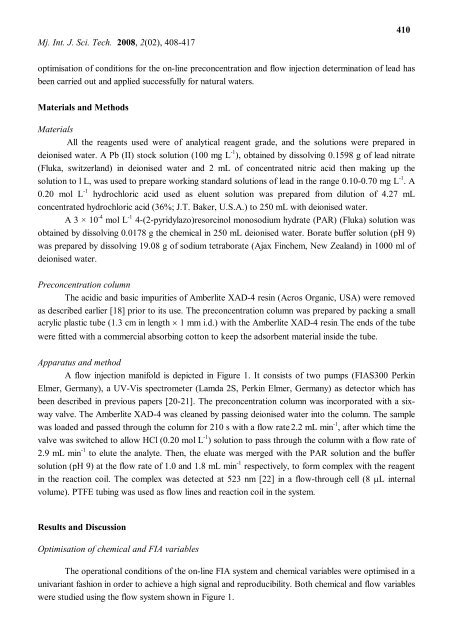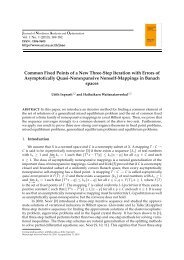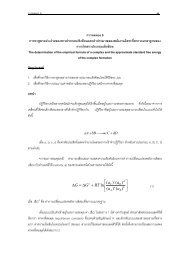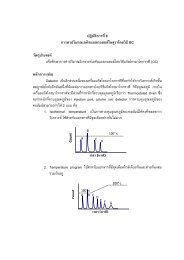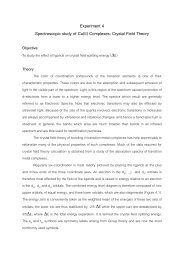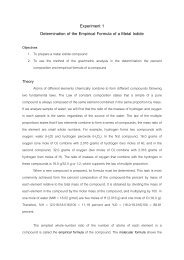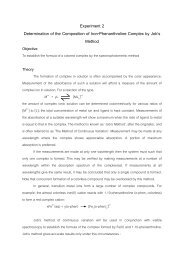A flow injection system for the spectrophotometric determination of ...
A flow injection system for the spectrophotometric determination of ...
A flow injection system for the spectrophotometric determination of ...
You also want an ePaper? Increase the reach of your titles
YUMPU automatically turns print PDFs into web optimized ePapers that Google loves.
Mj. Int. J. Sci. Tech. 2008, 2(02), 408-417<br />
410<br />
optimisation <strong>of</strong> conditions <strong>for</strong> <strong>the</strong> on-line preconcentration and <strong>flow</strong> <strong>injection</strong> <strong>determination</strong> <strong>of</strong> lead has<br />
been carried out and applied successfully <strong>for</strong> natural waters.<br />
Materials and Methods<br />
Materials<br />
All <strong>the</strong> reagents used were <strong>of</strong> analytical reagent grade, and <strong>the</strong> solutions were prepared in<br />
deionised water. A Pb (II) stock solution (100 mg L -1 ), obtained by dissolving 0.1598 g <strong>of</strong> lead nitrate<br />
(Fluka, switzerland) in deionised water and 2 mL <strong>of</strong> concentrated nitric acid <strong>the</strong>n making up <strong>the</strong><br />
solution to l L, was used to prepare working standard solutions <strong>of</strong> lead in <strong>the</strong> range 0.10-0.70 mg L -1 . A<br />
0.20 mol L -1 hydrochloric acid used as eluent solution was prepared from dilution <strong>of</strong> 4.27 mL<br />
concentrated hydrochloric acid (36%; J.T. Baker, U.S.A.) to 250 mL with deionised water.<br />
A 3 × 10 -4 mol L -1 4-(2-pyridylazo)resorcinol monosodium hydrate (PAR) (Fluka) solution was<br />
obtained by dissolving 0.0178 g <strong>the</strong> chemical in 250 mL deionised water. Borate buffer solution (pH 9)<br />
was prepared by dissolving 19.08 g <strong>of</strong> sodium tetraborate (Ajax Finchem, New Zealand) in 1000 ml <strong>of</strong><br />
deionised water.<br />
Preconcentration column<br />
The acidic and basic impurities <strong>of</strong> Amberlite XAD-4 resin (Acros Organic, USA) were removed<br />
as described earlier [18] prior to its use. The preconcentration column was prepared by packing a small<br />
acrylic plastic tube (1.3 cm in length 1 mm i.d.) with <strong>the</strong> Amberlite XAD-4 resin. The ends <strong>of</strong> <strong>the</strong> tube<br />
were fitted with a commercial absorbing cotton to keep <strong>the</strong> adsorbent material inside <strong>the</strong> tube.<br />
Apparatus and method<br />
A <strong>flow</strong> <strong>injection</strong> manifold is depicted in Figure 1. It consists <strong>of</strong> two pumps (FIAS300 Perkin<br />
Elmer, Germany), a UV-Vis spectrometer (Lamda 2S, Perkin Elmer, Germany) as detector which has<br />
been described in previous papers [20-21]. The preconcentration column was incorporated with a sixway<br />
valve. The Amberlite XAD-4 was cleaned by passing deionised water into <strong>the</strong> column. The sample<br />
was loaded and passed through <strong>the</strong> column <strong>for</strong> 210 s with a <strong>flow</strong> rate 2.2 mL min -1 , after which time <strong>the</strong><br />
valve was switched to allow HCl (0.20 mol L -1 ) solution to pass through <strong>the</strong> column with a <strong>flow</strong> rate <strong>of</strong><br />
2.9 mL min -1 to elute <strong>the</strong> analyte. Then, <strong>the</strong> eluate was merged with <strong>the</strong> PAR solution and <strong>the</strong> buffer<br />
solution (pH 9) at <strong>the</strong> <strong>flow</strong> rate <strong>of</strong> 1.0 and 1.8 mL min -1 respectively, to <strong>for</strong>m complex with <strong>the</strong> reagent<br />
in <strong>the</strong> reaction coil. The complex was detected at 523 nm [22] in a <strong>flow</strong>-through cell (8 L internal<br />
volume). PTFE tubing was used as <strong>flow</strong> lines and reaction coil in <strong>the</strong> <strong>system</strong>.<br />
Results and Discussion<br />
Optimisation <strong>of</strong> chemical and FIA variables<br />
The operational conditions <strong>of</strong> <strong>the</strong> on-line FIA <strong>system</strong> and chemical variables were optimised in a<br />
univariant fashion in order to achieve a high signal and reproducibility. Both chemical and <strong>flow</strong> variables<br />
were studied using <strong>the</strong> <strong>flow</strong> <strong>system</strong> shown in Figure 1.


